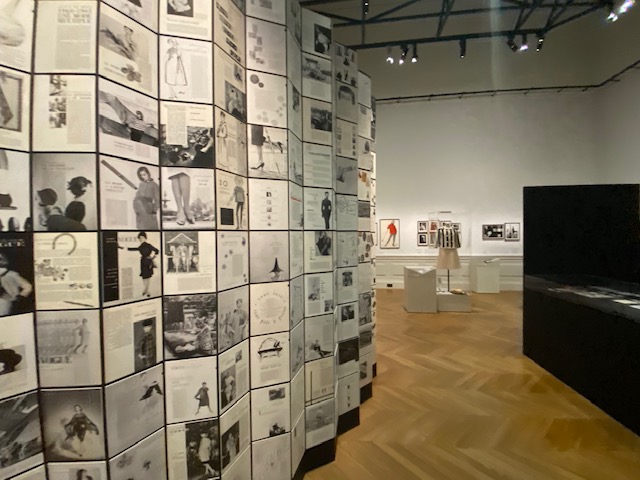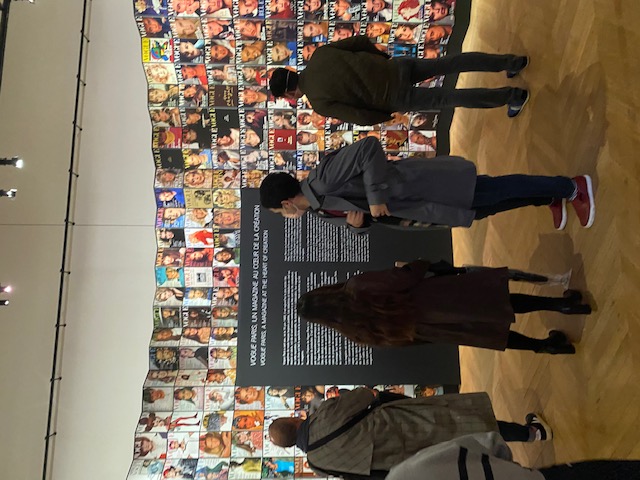Delving into the Political Roots of Vogue Paris

An exhibition celebrating 100 years of Vogue Paris debuted on October 2, 2021 at the Palais Galliera, where visitors can witness the social, cultural, political and artistic influences that shaped the magazine. Through a chronological curation of visual and auditory texts, the exhibition aimed to display the publication's evolution through several distinct eras. The social realities that influenced the globalized iconography of the '90s and the Parisian renaissance of the '50s were explained at length in the exhibition, proving that Vogue Paris maintained a commitment as a cultural arbiter throughout its history.
The remarks of editors, writers, and the exhibition's curators emphasized the romantic image of the ultimate Parisian that Vogue Paris increasingly aimed to achieve through its content. Reality merged with idealism and created the publication's uniquely relevant yet visionary editorials.

Image Credit: Claire Moberg
The exhibition opened with a panoramic collage of more than 1000 covers published over the last century. The introductory guide amidst these images described the history of the magazine's publication for further context. The rest of the exhibition took the visitor through the history of the magazine chronologically.
Each era of the magazine was shown through behind the scenes photographs, letters, videos, and descriptions of the socio-political context that was pervasive in the editorials. The clothing and accessories worn by models on the cover and in various editorials were intermixed with the displayed prints of the magazine.

Image Credit: Claire Moberg
The last edition before the continent was overwhelmed by World War II and the first edition after the Allies declared victory were displayed in stark contrast. Editor-in-Chief Michel de Brunhoff wrote a letter to Conde Nast detailing the difficulties Paris was facing at the war's precipice, which was exhibited in its original form.
"While it was necessary to retain the deluxe appearance indispensable to our magazine, the hard-to-solve problem was not to hurt the feelings of people whose nerves are overstrung in France," the letter read.

Image Credit: Claire Moberg
The romantic and indulgent work of the magazine in the '20s was short-lived. The editorial staff could not ignore the complex political reality of Paris, a city simultaneously embracing and resisting Nazi ideology. The beginning months of the war were frantic in the capital, ultimately leading to sporadic publication near the end of 1939. After Nazi forces raided the Vogue Paris offices in June 1940, the magazine was out of print until the war ended in 1945.
The period after the war was considered one of the magazine's peaks, according to textual descriptions on display. Paris had a cultural rebirth in the '50s and '60s that invigorated the French spirit. Arts and culture weren't limited to the upper class, but were now accessible to the average Parisian.
The magazine, reflective of the period, produced content that appealed to a wider audience. The fashion in this era was more experimental, less restrictive, and seen as a mode of self-expression for the women wearing the clothes and the designers.
Yves Saint Laurent and Hubert de Givenchy were mid-century French designers who symbolized a new age of fashion. The fashion world had an impressionist awakening, with Vogue Paris at the helm.

Image Credit: Claire Moberg
All mediums of art stood alongside fashion in the magazine's pages. Various prominent artists collaborated with Vogue Paris throughout its history. Pablo Picasso drew a subversive cover in 1951, shown its original edition behind a glass display. Salvador Dali also leant his work to editorials for the magazine. The fashion world and the renowned art world unified.
Despite historic marginalization of women and designers of color in the magazine, Parisian Vogue distinguished itself from American Vogue on the topic of representation. While Vogue Paris began to embrace a more diverse array of models in their editorials, their mother publication refused. Beyond this example, the struggles that marginalized contributors to the magazine faced were not elaborated on extensively in the exhibition.
"African-American model Pat Cleveland described how her beauty was praised regardless of her ethnic background in Paris," read the photo description for photographs from an April 1966 spread, "in the 1960s, this indifference was reported by almost all black models during their French stays, from Helen Williams to Donyale Luna."

Image Credit: Claire Moberg
Vogue Paris has continued to embrace modernity in every era of its history. Multimedia examples within the exhibition included video interviews, online exclusive images from editorials, and podcast clips . The publication has not shied away from the new digital age and modified its print content for online consumption. Similar to her predecessors, Editor-in-Chief during the 2010s, Emmanuelle Alt, attempted to push fashion into the world of culture and politics.
In the latter half of its evolution, the magazine extended beyond the borders of France and touched on widely-applicable topics. Nelson Mandela and the Dalai Lama both covered editions of the magazine in the early '90s. The editorial staff embraced a new political world of cross-cultural discourse, according to the exhibition. A globalized market demanded this focus.

Image Credit: Claire Moberg
The distinction between the magazine's uniquely Parisian spirit in the '50s to the international appeal of the '90s was evident as visitors walked through the array of visual media. The recent decade at Vogue Paris attempted to rectify the political struggle between niche Parisian idealism and cross-cultural discourse.
The modern examples of the publication included the images of French women as an aesthetic that could be achieved no matter one's background. Vogue Paris embraced both the unique dynamics of the modern French capital and its global appeal. This shift was necessary to remain relevant in a city that has remained at the center of global politics, art, and culture.
Despite its cultural significance, the magazine is currently headed towards an uncertain future. Editor-in-Chief, Emmanuel Alt, was let go last month and there are no current plans for a replacement. The Conde Nast company is in the midst of plans to consolidate global branches of their publications into the editorship of Anna Wintour, global editorial director.
The temporary exhibition debuted on October 2, 2021 and will be on display through January 30, 2022.
The Palais Galliera also has a permanent exhibition on the history of fashion from the 18th century to the modern era.
Tickets must be reserved online ahead of the visit. A Passe Sanitaire is required for entry.





